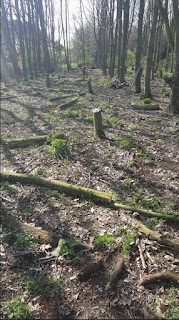Norbury Park.
On Friday 21st July 2023 Small Woods members collected early in the overflow car park at the BIFoR
FACE facility. We were welcomed by refreshments and good weather, before cramming
into as few cars as possible for the drive to the Long Barn. A 1740’s threshing
barn that has been renovated as a beautiful conference hall. We were each
greeted with a copy of Jo Bradwell’s book “Norbury Park, An estate tackling
climate change”. Jo Bradwell gave us a presentation of his approach to woodland
management.
Professor
Bradwell explained his non-agricultural background and how a desire to offset
his “Carbon Guilt” had led to the acquisition of Norbury Park. Starting from a
position of “I don’t know what to plant so I’ll plant everything”. His initial
aim was to maximise carbon sequestration, in the established woods, newly
planted woods and later on the arable land. The farm moved from arable to mixed
grasses for silage and then to complex herbal lays. Increased production has
long been shown for mixed pastures, particularly when nitrogen fixing legumes
are included. The increased carbon in the soil accounted for half the over 5,000
tonnes net of CO2 sequestered by the estate in 2020 mainly by the farm soil.
In the
woodlands he has developed a novel woodland management system. It is based on
four principles. 1: Individual species are more productive in intimate mixtures,
than in monocultures. 2: Greater leaf area in the maximum amount of light
allows greatest growth. So, choose the trees you wish to favour early and
remove the crowns of competing trees, hence Halo-Pollarding. Allowing the
pollards to keep sequestering carbon. 3: As Nitrogen is often the limiting
nutrient in biological systems, include nitrogen fixing trees in your
mixtures. 4: Control pests particularly
those that you can. Infection rates are reduced in intimate mixtures. Deer and
squirrel numbers are kept as low as possible.
Non-anecdotal
evidence for increased productivity in tree mixes is lacking in the U.K. but
scientific papers were referenced showing it in natural and plantation stands
abroad. There appear to be three main causes. Greater variety and depth of the
canopy and understory enabling more light to be utilised. Greater variety in
the depth that roots can extract water and minerals from, and possibly most
significantly reduced pests and diseases. Though there is a wider range of
pathogens and pests there is a wider range of predators and further between
potential hosts. Species variety is considered key to reducing infection rates.
The
presentation included examples of trees from the estate. A section of an 11
year old Hybrid Larch and 33 year old one of similar size from an estate
monoculture were handed round. Powerful evidence for competition removal, but
not necessarily for mixtures without knowing the thinning history of the
monoculture. It is not known how the Forestry Commission had thinned the stand.
Professor
Bradwell went on to explain the paucity of European species following the ice
ages. Species failed to return across East-West aligned obstacles like the
Mediterranean, the Pyrenees and the Alps. He advocated considering non-native
species.
The
presentation lasted about 35 minutes. There were many questions, several about
carbon accounting. The major downside appears to be the complexity of the
management and the extra labour required.
We then set
off into the woods. The first stop was by an example of a squirrel trap that
was being developed. It was table mounted and based on the lethal Kania spring
bolt squirrel trap. The estate had believed vertically mounted bolt traps
tended to have unacceptable bycatch rates. The new trap was inclined to the horizontal,
at 20 degrees. A feed hopper allowed corn bait to trickle out. There was also a
trap door triggered after the bolt was sprung. This allowed any catch to fall
to the floor and be scavenged, eliminating the necessity of daily inspection. The
estate spends £16,000 a year on squirrel control, mainly because the 100 traps
are inspected daily during the summer when trees are most at risk. It is hoped
that after further trials and tweaks the trap will be made commercially
available.
Our second
stop was at the first of the mixed plantations from 2009. The diverse species
range was immediately apparent. It lacked non-commercial conifers or nonnative
broadleaves. Though the later were seen in later plantings. Examples of winners
were obvious because of their girth and an orange band! Most of these were
surrounded by trees that had been pollarded. Pollarding keeps the regrowth above
deer foraging and allows carbon sequestration in the trunks and roots. It will
be interesting to see the timber crop in 20 or 30 years. We did see an
impressive Hybrid Larch. It was next to a Larch stump of nearly equal
proportions, a slice of which was placed nearby and measured at 13” diameter.
As a first planting it was very impressive and will have provided valuable
lessons for the later plantings. There was plenty to inspire anyone thinking of
woodland creation.
Driving back
past bits of mature woodland and small patches of different planting dates, it
was apparent non-native hardwoods were now being planted. Our tree ID skills
were challenged. Then there was another chance to admire the Long Barn again
over our lunches.
I have independently come to approach woodland management in much the same way as Prof Bradwell but think his case is not as strong as he tries to make it appear.









